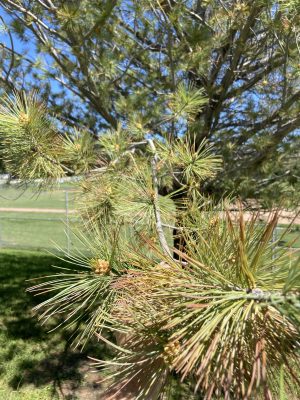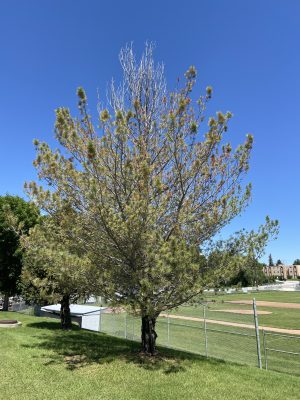 In contrast to this year’s bountiful moisture, the last few years were relatively dry in our region. Along with several new record low temperatures during the winter of 2022–2023, these conditions have severely stressed many trees in the Johnson County landscape.
In contrast to this year’s bountiful moisture, the last few years were relatively dry in our region. Along with several new record low temperatures during the winter of 2022–2023, these conditions have severely stressed many trees in the Johnson County landscape.
I have received many calls at the Johnson County extension office about spruce trees that appear to be dying. Evergreen trees are particularly susceptible to winter injury because they retain green living tissue that continues to grow through the winter. This process requires water, which is often unavailable due to frozen topsoil or a lack of precipitation.
The signature sign of winter injury is rust-colored or orange needles. Even with last winter’s heavy snow cover, moisture available to plant roots was limited by frozen soils. As the trees try to keep growing during the winter, they use up their root water stores and begin to experience stress in a process called desiccation.
The best treatment option is to provide sufficient water and wait. Many evergreen trees will set new growth, called candles, as temperatures warm; with time, these trees will recover. Dead branches that are not showing new growth can be pruned off to improve the tree’s appearance. Trees that have turned completely orange may not be recoverable.
How to water

I mention sufficient watering above. But what does that mean? How much water is enough? Where should irrigation water be targeted to best serve the tree? Trees are not like turf lawns. They prefer deep, infrequent watering. Many factors, including soil type, tree species, tree age, and local weather affect how much supplemental watering a tree requires.
The Wyoming State Forestry Department recommends that in the first three years after planting, a tree should receive 1.5 gallons of water per inch of trunk diameter when the soil is dry. Drip systems installed to irrigate new trees are quickly outgrown and usually don’t keep up with water needs after a few years. For established and mature trees, the recommendation is to water long enough to saturate the top 10 to 12 inches of soil. Moisture penetration can be determined by digging down with a spade or by probing with a long screwdriver. When the dry soil layer is reached, it will feel solid or very difficult to push through with the tool.
Sprinklers should be placed under the perimeter of the farthest-reaching branches, known as the dripline, which extends in a ring around the tree. Trees grow roots to absorb rain falling off the ends of branches in this area, and watering in this space maximizes water use.
A 2- to 4-inch layer of wood chip mulch around trees will help reduce water evaporation, provide extra insulation during the winter, and boost a tree-friendly microbe population in the soil.
Timing and tree health
The best way to prevent winter injury is to make sure that trees are well hydrated during the transition from fall to winter. Trees that are watered to the saturation point before the first frost fare better in the spring. Trees and shrubs can be safely watered during the winter months if the temperature reaches 40 degrees Fahrenheit and the soils are not frozen solid.
Trees that suffered winter injury may not show signs until well after winter ends. As mentioned above, providing water is key. While it may be tempting to apply fertilizer to a struggling tree, this can actually make the stress worse and extend the recovery period. Wait until the tree has recovered and resumed normal growth before applying fertilizer.
The rainfall in early summer provided welcome hydration to evergreens and other trees in our area and has demonstrated the ups and downs of our wonderful Wyoming weather. Some species of trees and landscaping plants are more resilient to these fluctuating conditions, while others require more water, time, and attention. Selecting species that are a good fit for your location and climate is one way to help boost the lifespan and beauty of your trees.
Further reading on these subjects is available through the University of Wyoming Barnyards & Backyards website and at local UW Extension offices.
Micah Most is the University of Wyoming Extension agriculture and natural resources educator based in Johnson County. He can be reached at mmost@uwyo.edu or (307) 684-7522.




